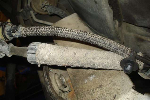Today I tackled the power steering pump. My goal was to completely disconnect it from the engine without disconnecting any of the fluid lines. I did not remove the water pump pulley or the power steering pump pulley. There are holes in the power steering pump pulley that allow removal of the pump mounting bolts without removing the pulley. I left one of the three bolts in place until after disconnecting the reservoir mounting bolts. I disconnected the hose positioning bracket below the pump but overlooked the one under the A/C compressor that is visible from the left fender well. The photo below shows the steering pump after I was able to work it past the water pump pulley.
View attachment 58170
There's a plastic pin on the bottom of the reservoir that fits in the mounting bracket. The reservoir must be raised the length of the pin before the entire assembly can be moved forward and down out of the way. I realized there was still a hose positioning attachment in place when I tried to raise the reservoir. The hose has to slide past the A/C compressor before the steering assembly can be lowered out of the way.
It is necessary to disconnect the A/C compressor clutch electrical connector to get the hose past. It took me about 20 minutes to get the connector to release because it's not the squeeze type like I assumed. The photo below shows how neatly the power steering assembly can be tucked out of the way.
View attachment 58178













